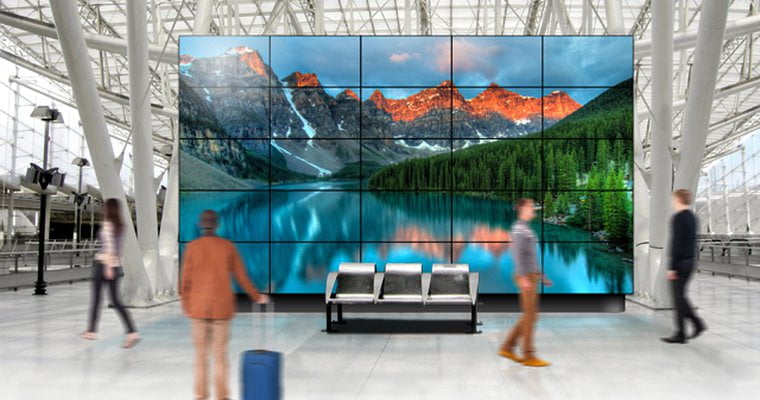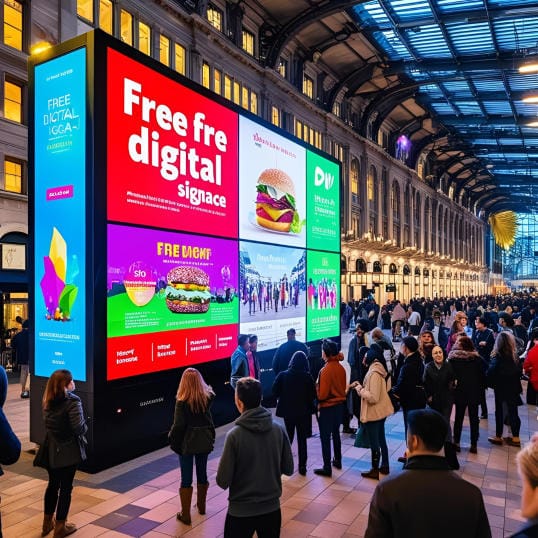A well-built digital signage video wall changes simple screens into tools for communication that attract people and present current information. If you use digital signage video wall displays client on smart TVs, select a free digital signage app, or examine the top Android software for digital signage video walls, the right platform makes it easy to handle and show media content anywhere. Since there is a high demand for digital signage in shopping centers, hotels, companies, schools, and hospitals, it is important to use an app that combines necessary functions with extra features to help your brand improve processes and create interesting experiences for viewers.
 1. Plan Your Content Strategy
1. Plan Your Content Strategy
Define Your Objectives
The first thing to do is determine the reason for installing a digital signage video wall. For branding purposes, make sure the main focus is on powerful images and videos that repeat the brand’s identity everywhere on the screen. For advertising, keep switching between product promotions and special offers at the time when most people are using your site. Wayfinding walls and corporate dashboards need text that is easy to read, clear icons, and live information coming from the video walls software you are using. When you have a clear core purpose from the beginning, every design and planning step is easier.
Know Your Context & Placement
The surroundings where a video wall is installed play a big role in determining the content shown. Exterior installations need displays that are very bright and simple images to be visible and understood by people passing quickly. Suites and indoor lobbies can make use of more detailed information—weather, news, or welcome messages using your video walls. Because people stay for different lengths of time, plan what to show: fast clips in busy areas and longer informative segments in more peaceful galleries or museums.
Audience Engagement
Keeping everyone busy on the screens makes sure that what you’re doing is not background noise. Include interactive things—live feeds from social media, polls that update in real-time, QR codes that guide visitors to mobile applications, and sensors that start relevant content—to turn your video wall digital signage into an interactive and interesting experience. Because of these features, people are encouraged to interact with your display over and over again.
2. Nail Your Layout & Visual Hierarchy
Aspect Ratio & Screen Configuration
No matter the size of the video wall, each arrangement comes with a unique aspect ratio that should not be distorted. A 2×2 setup has panels in the 16:9 ratio, but a 1×3 or 3×3 setup produces unusual aspect ratios (48:9 or 48:27). Arranging your content on the final canvas guarantees that logos, text, and UI elements are not distorted and look clear. The majority of video wall digital signage platforms let you pick your own canvas sizes to get the most accurate results.
Grids & Artistic Layouts
While regular grids are predictable, making the layout with mixed panels, turning them in various directions, or having a large screen surrounded by smaller ones makes the design more dramatic and eye-catching. You can often use flexible templates in digital signage video walls to place portrait and landscape panels side by side or place content on different layers. Asymmetry and depth in signage can help your design stand out above the others.
Visual Hierarchy: Fonts, Size, Contrast
It is important for video wall digital signage to be well organized. All headlines should be written in big, bold text (60–80 pt or above, depending on how far away they are) to get noticed right away. Supporting information is grouped under subheadings, which are smaller and are placed appropriately in the layout. Dark text on a light background, or the other way around, makes the design easier to read far away, and matching spacing and colors strengthen the brand’s look. A strong hierarchy makes sure that the main points are noticed by viewers, even if they look for only a short time.
 3. Optimize Resolution, Scaling & File Formats
3. Optimize Resolution, Scaling & File Formats
Match Display Resolution
Design the content to use the full space of the video wall, no matter if it is a 4K screen or a custom 1080p wide display. This kind of design guarantees that all the tiny elements, like logos, charts, or text, are sharp on every device. When you use digital signage video walls software, set your canvas size so your video doesn’t appear blurry or out of proportion.
Scaling vs. Pixel Perfect
Choose if you want to stretch or letterbox the content or if you’d prefer to keep the picture quality by using crops or borders. Logos and fine artwork should be placed exactly, but looping videos and background animations are not affected by slight changes in size. Several video wall digital signage systems let you choose every asset if you want it to fill the zone or fit within it, helping you manage distortion and blank spaces.
File Formats & Encoding
MP4 containers and H.264 or H.265 (HEVC) encoding are the best settings for video files to avoid stutters. If you want clear images, use high-resolution JPEG or PNG with transparency. For animations, you can use GIFs or short-version MP4 files. Captions should be added to video files or given as separate subtitles so that everyone can read them. Ensuring that you have the right encoding and formats in your video walls software will ensure your content is presented properly.
4. Use Color, Contrast & Brightness Wisely
Ambient Brightness Management
Since video walls are often used in bright locations, they need more luminance. However, too much brightness can lead to earlier LED failure. Having a dark backdrop and splashes of bright colors helps both your eyes and your screen. You can change the brightness of your video wall display using the digital signage controls at different times or in response to the outside light.
Color Contrast for Readability
Having light colors on dark backgrounds increases the legibility of the text and images from a distance. Using WCAG contrast checkers allows you to find accessible color choices. Because in video wall digital signage, the distance to view can be over 30 feet, it is important that contrast is strong to help keep vital information recognizable in all situations.
Avoid Burn-In & Excessive Brightness
If static parts of the screen are displayed for too long, they may leave marks or uneven damage on the LED video wall. Change the position of fixed items, add light movement (slowly fade out colors), and make sure there are not too many pure white spots. If digital signage video walls software are properly taken care of, they will remain vivid and uniform throughout their life.
5. Motion, Captions & Engagement Tech
Motion vs. Static
Moving images naturally attracts attention, so adding video loops, animated effects, and small motions increases the viewer’s interest in your video wall. It’s easy to move the viewer’s eye around too much, so use fully animated parts when it’s most important and then give the viewer a break with calm or slightly moving content.
Captions and Accessibility
If you can’t play audio, having a muted video with clear captions works best in lobbies and aisles in retail stores. Captions make sure that those with hearing problems can follow what the video is showing and also help in noisy environments.
Interactivity: QR Codes & Sensors
They give you the size of a video wall with the convenience of a mobile device. Place QR codes that direct people to promotions, surveys, or where they can register for events. These sensors allow you to greet people personally or show them relevant messages as they come by. When digital video walls are combined with interactive technology, people in the audience are involved rather than just watching.
6. Maintain Content Freshness & Relevance
Scheduling & Rotations
A video wall that does not change can look old easily. Take advantage of your CMS’s scheduling options to change the displayed content depending on the time or the day. People commuting in the morning notice the weather and traffic, people having lunch notice restaurant menus, and those in the evening watch stories about brands.
Context-Aware Updates
With external APIs and calendar feeds, the software is able to show content that matches the current weather or upcoming events. Sending rainy-day deals, notifying you about upcoming events, or customizing ads for your audience makes your wall always fresh.
Analytics & CMS Utilization
Track which parts of your website get the most hits and keep visitors engaged with the in-built analytics. Use what you learn to edit your content, adjust the length of loops, and find assets that are not doing well. Using data leads to steady progress in your video wall digital signage system.
7. Branding & Calls to Action
Consistent Brand Identity
Ensure that logos, colors, fonts, and the tone you use are present throughout your website. Using light animations for your logo between content sections helps people remember your brand while still making sure the main message is clear.
Clear Calls to Action
When you want viewers to join, visit your site, or use a code, write clear CTAs and make sure they stand out and appear when most people are watching. You should include CTAs at the end of video loops or during gaps in motion graphics to get the most conversions.
 8. Common Pitfalls & How to Avoid Them
8. Common Pitfalls & How to Avoid Them
Overcrowding & Information Overload
Putting too many messages on a big canvas reduces their strength. Focus on one important point in your loop, and only include a little extra information. A little bit of empty space on a page allows the audience to focus on the content.
Ignoring Contextual Fit
Placing dark videos on bright walls or gentle animations in crowded places will make them difficult to spot. Make sure visuals, the speed of the show, and brightness match the setting and how the audience behaves.
Technical Missteps
Typically, people face problems with distorted visuals from wrong resolution, sound-but-no-captions for videos played in noisy places, and static images that stay for too long and can burn the screen. Avoiding these mistakes requires running tests in the software sandbox and doing trial runs on-site.
FAQ – Digital Signage Video Wall
What resolution should I use for a video wall?
Set your design to the exact size of the whole video wall canvas to avoid any unwanted scaling or blurry effects.
How do I avoid burn-in on LED video walls?
Change the static elements, avoid using only white backgrounds, add small animations to the UI chrome, and supervise the luma levels. Having darker backgrounds and lively accent colors ensures your shoes do not become unevenly worn.
Should I use motion graphics or static images?
Animated loops draw more viewers, so use them for the main points and keep the other sections with static graphics. Mix them up to prevent the audience from getting bored.
How can I make content readable from a distance?
For each 10 feet further from the sign, make the text 20% bigger, use strong contrast, and arrange the messages in a clear order from top to bottom.
Is audio necessary in video wall content?
Public areas should use muted videos with captions that are superimposed on the screen. Sound in videos can be bothersome and might miss some viewers.
How often should content be updated?
Change short-lived promotions several times a day, update your daily headlines or menus at scheduled times, and update your constant branding or stories seasonally. Make use of the CMS’s scheduling feature to ensure time is managed precisely.
What file formats are best?
Use videos encoded in MP4 with H.264 or H.265 and images in JPEG or PNG high-resolution format, and make sure the HTML5 widgets are adaptable to any device. Do not compress your files so much that they display artifacts on big screens.
How do I create content for irregular video wall layouts?
Sony Ziris and Userful enable you to use any screen arrangement, so you can place your content on curved monitors or panels of different sizes.
Should I add interactive elements?
Absolutely. QR codes, animations that respond to movement, and live social media feeds make visitors stay longer and offer important data on their actions.
How can I measure content success?
Review the analytics from the CMS, including video log playback, impressions, time spent on each video, and the scan rates of QR codes, to find what works well and make your digital signage strategy better as time goes by.


 1. Plan Your Content Strategy
1. Plan Your Content Strategy 3. Optimize Resolution, Scaling & File Formats
3. Optimize Resolution, Scaling & File Formats 8. Common Pitfalls & How to Avoid Them
8. Common Pitfalls & How to Avoid Them


